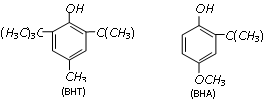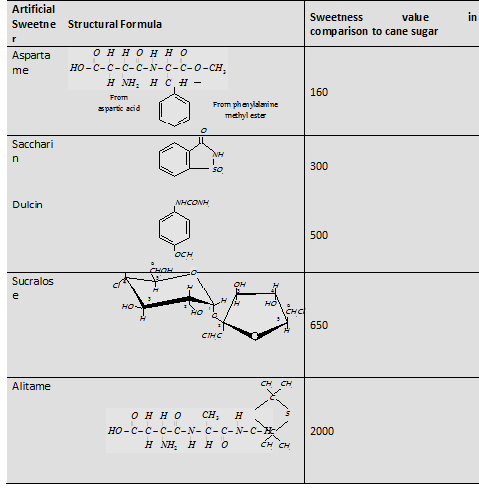Chemicals in food
Many chemicals are added to food for their preservation and enhancing their appeal. These include flavorings, sweeteners, dyes, antioxidants, fortifiers, emulsifiers and antifoaming agents. With the exception of the preservatives, antioxidants, fortifying agents and artificial sweeteners, the remaining classes of chemicals mentioned above are added either for ease in processing or for cosmetic reasons, in the actual sense these have no nutritive value.
(1) Antioxidants: Antioxidants are the important and necessary food additives. These substances retard the action of oxygen on the food and thereby help in its preservation. These react as sacrificial compounds, i.e., these are more active towards oxygen than are the materials they are protecting. They also cut the rate of involvement of free radicals in the aging procedure. The two most known antioxidants used are butylated hydroxy toluene (BHT) and butylated hydroxy anisole (BHA). The addition of BHA to butter increases its storage life from months to years. The two have the subsequent structures.

Sometimes BHT and BHA are added in combination with citric or ascorbic acids to produce a more active synergietic effect. Sulphur dioxide and sulphite are useful antioxidants for wine and beers, cut peeled or dried fruits, sugars syrups and vegetables.
(2) Preservatives: The preservatives prevent spoilage of food due to microbial expansion. The most general preservative used is sodium benzoate; C6H5COONa It is metabolized by conversion to hippuric acid, C6H5CONH CH2COOH which ultimately is excreted in the urine. Salts of sorbic acid and propionic acid are also used as preservatives.
(3) Artificial sweetener: The artificial sweeteners are another type of food additives. The first admired synthetic sweetener was saccharin. It was advertised as its water soluble sodium or calcium salt. Saccharin is just about 300 times sweeter than cane sugar. It has confirmed to be a lifesaver for countless diabetics and is of great value to people who need to control intake of calories.
Besides saccharin, the other usually promoted artificial sweeteners are described here.
Aspartame is unstable at cooking temperatures, limiting its use as a sugar alternate to cold foods and soft drinks. Alitame is more constant than aspartame throughout cooking. One potential trouble with alitame and similar type of high-potency sweetners is the difficulty in controlling sweetness of food. Sucralose is guessed to become a great commercial success
Table

4) Edible colours: Edible colours used for food are basically dyes. The use of food dyes is particularly wide spread. They are used to colour everything from meat to fruit. For case, dyes are used to dye orange peels so that oranges retain their colour. Colour is one of the ingredients in fruit juices. There is a huge deal of argument over the potential harm the dyes can cause. This argument becomes more meaningful particularly keeping in view the fact that food dyes add nothing to the nutritive value of food. The use of azo dyes has elevated considerable anxiety in that some of them are dangerous for young children and asthma patients. Tetrazine, a very generally needed dye is particularly a suspect. However, natural dyes like Carotene are safe food edible colours. For protection of consumer interests, the government of India have passed Prevention of Food Adulteration act (PFA).
Email based Chemistry assignment help - homework help at Expertsmind
Are you searching chemistry expert for help with Chemicals in food questions? Chemicals in food topic is not easier to learn without external help? We at www.expertsmind.com offer finest service of Chemistry assignment help and chemistry homework help. Live tutors are available for 24x7 hours helping students in their Chemicals in food related problems. We provide step by step Chemicals in food question's answers with 100% plagiarism free content. We prepare quality content and notes for Chemicals in food topic under chemistry theory and study material. These are avail for subscribed users and they can get advantages anytime.
Why Expertsmind for assignment help
- Higher degree holder and experienced experts network
- Punctuality and responsibility of work
- Quality solution with 100% plagiarism free answers
- Time on Delivery
- Privacy of information and details
- Excellence in solving chemistry queries in excels and word format.
- Best tutoring assistance 24x7 hours